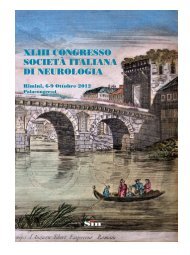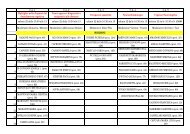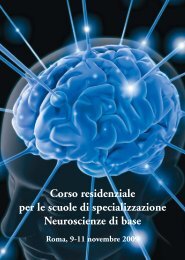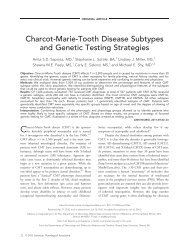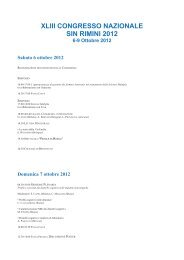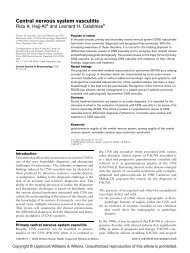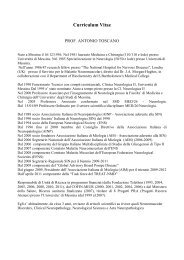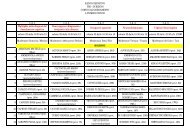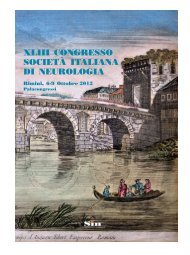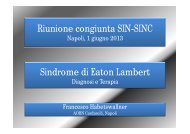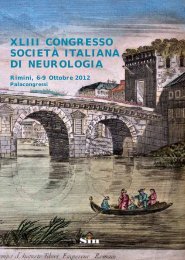Glucose transporter-1 deficiency syndrome: the expanding clinical ...
Glucose transporter-1 deficiency syndrome: the expanding clinical ...
Glucose transporter-1 deficiency syndrome: the expanding clinical ...
- No tags were found...
Create successful ePaper yourself
Turn your PDF publications into a flip-book with our unique Google optimized e-Paper software.
670 | Brain 2010: 133; 655–670 W. G. Leen et al.Klepper J, Leiendecker B. GLUT1 <strong>deficiency</strong> <strong>syndrome</strong>–2007 update.Dev Med Child Neurol 2007; 49: 707–16.Klepper J, Scheffer H, Leiendecker B, Gertsen E, Binder S, Leferink M,et al. Seizure control and acceptance of <strong>the</strong> ketogenic diet in GLUT1<strong>deficiency</strong> <strong>syndrome</strong>: a 2- to 5-year follow-up of 15 children enrolledprospectively. Neuropediatrics 2005; 36: 302–8.Klepper J, Voit T. Facilitated glucose <strong>transporter</strong> protein type 1 (GLUT1)<strong>deficiency</strong> <strong>syndrome</strong>: impaired glucose transport into brain—a review.Eur J Pediatr 2002; 161: 295–304.Klepper J, Wang D, Fischbarg J, Vera JC, Jarjour IT, O’Driscoll KR, et al.Defective glucose transport across brain tissue barriers: a newly recognizedneurological <strong>syndrome</strong>. Neurochem Res 1999b; 24: 587–94.Klepper J, Willemsen M, Verrips A, Guertsen E, Herrmann R, Kutzick C,et al. Autosomal dominant transmission of GLUT1 <strong>deficiency</strong>. HumMol Genet 2001; 10: 63–8.Mueckler M, Caruso C, Baldwin SA, Panico M, Blench I, Morris HR, et al.Sequence and structure of a human glucose <strong>transporter</strong>. Science 1985;229: 941–5.Mueckler M, Makepeace C. Analysis of transmembrane segment 10 of<strong>the</strong> Glut1 glucose <strong>transporter</strong> by cysteine-scanning mutagenesisand substituted cysteine accessibility. J Biol Chem 2002; 277:3498–503.Mueckler M, Makepeace C. Model of <strong>the</strong> exofacial substrate-binding siteand helical folding of <strong>the</strong> human Glut1 glucose <strong>transporter</strong> based onscanning mutagenesis. Biochemistry 2009; 48: 5934–42.Overweg-Plandsoen WC, Groener JE, Wang D, Onkenhout W,Brouwer OF, Bakker HD, et al. GLUT-1 <strong>deficiency</strong> without epilepsy–an exceptional case. J Inherit Metab Dis 2003; 26: 559–63.Roulet-Perez E, Ballhausen D, Bonafe L, Cronel-Ohayon S, Maeder-Ingvar M. Glut-1 <strong>deficiency</strong> <strong>syndrome</strong> masquerading as idiopathicgeneralized epilepsy. Epilepsia 2008; 49: 1955–8.Salas-Burgos A, Iserovich P, Zuniga F, Vera JC, Fischbarg J. Predicting <strong>the</strong>three-dimensional structure of <strong>the</strong> human facilitative glucose <strong>transporter</strong>glut1 by a novel evolutionary homology strategy: insights on <strong>the</strong>molecular mechanism of substrate migration, and binding sites forglucose and inhibitory molecules. Biophys J 2004; 87: 2990–9.Sato M, Mueckler M. A conserved amino acid motif (R-X-G-R-R) in <strong>the</strong>Glut1 glucose <strong>transporter</strong> is an important determinant of membranetopology. J Biol Chem 1999; 274: 24721–5.Schneider SA, Paisan-Ruiz C, Garcia-Gorostiaga I, Quinn NP, Weber YG,Lerche H, et al. GLUT1 gene mutations cause sporadic paroxysmalexercise-induced dyskinesias. Mov Disord 2009; 24: 1684–8.Schouten JP, McElgunn CJ, Waaijer R, Zwijnenburg D, Diepvens F,Pals G. Relative quantification of 40 nucleic acid sequences by multiplexligation-dependent probe amplification. Nucleic Acids Res 2002;30: e57.Schurmann A, Doege H, Ohnimus H, Monser V, Buchs A, Joost HG. Roleof conserved arginine and glutamate residues on <strong>the</strong> cytosolic surfaceof glucose <strong>transporter</strong>s for <strong>transporter</strong> function. Biochemistry 1997;36: 12897–902.Seidner G, Alvarez MG, Yeh JI, O’Driscoll KR, Klepper J, Stump TS, et al.GLUT-1 <strong>deficiency</strong> <strong>syndrome</strong> caused by haploinsufficiency of <strong>the</strong>blood-brain barrier hexose carrier. Nat Genet 1998; 18: 188–91.Shows TB, Eddy RL, Byers MG, Fukushima Y, Dehaven CR, Murray JC,et al. Polymorphic human glucose <strong>transporter</strong> gene (GLUT) is onchromosome 1p31.3—p35. Diabetes 1987; 36: 546–9.Slaughter L, Vartzelis G, Arthur T. New GLUT-1 mutation in a child withtreatment-resistant epilepsy. Epilepsy Res 2009; 84: 254–6.Suls A, Dedeken P, Goffin K, Van Esch H, Dupont P, Cassiman D, et al.Paroxysmal exercise-induced dyskinesia and epilepsy is due to mutationsin SLC2A1, encoding <strong>the</strong> glucose <strong>transporter</strong> GLUT1. Brain 2008;131: 1831–44.Takahashi S, Ohinata J, Suzuki N, Amamiya S, Kajihama A, Sugai R, et al.Molecular analysis and anticonvulsant <strong>the</strong>rapy in two patients withglucose <strong>transporter</strong> 1 <strong>deficiency</strong> <strong>syndrome</strong>: a successful use of zonisamidefor controlling <strong>the</strong> seizures. Epilepsy Res 2008; 80: 18–22.Ticus I, Cano A, Villeneuve N, Milh M, Mancini J, Chabrol B. [GLUT-1<strong>deficiency</strong> <strong>syndrome</strong> or De Vivo disease: a case report]. Arch Pediatr2008; 15: 1296–9.Vannucci SJ, Maher F, Simpson IA. <strong>Glucose</strong> <strong>transporter</strong> proteins in brain:delivery of glucose to neurons and glia. Glia 1997; 21: 2–21.Vermeer S, Koolen DA, Visser G, Brackel HJ, Van der Burgt I, DeLeeuw N, et al. A novel microdeletion in 1(p34.2p34.3), involving<strong>the</strong> SLC2A1 (GLUT1) gene, and severe delayed development. DevMed Child Neurol 2007; 49: 380–4.Wang D, Kranz-Eble P, De Vivo DC. Mutational analysis of GLUT1(SLC2A1) in Glut-1 <strong>deficiency</strong> <strong>syndrome</strong>. Hum Mutat 2000; 16:224–31.Wang D, Pascual JM, Yang H, Engelstad K, Jhung S, Sun RP, et al.Glut-1 <strong>deficiency</strong> <strong>syndrome</strong>: <strong>clinical</strong>, genetic, and <strong>the</strong>rapeutic aspects.Ann Neurol 2005; 57: 111–8.Wang Y, Zhou J, Minto AW, Hack BK, Alexander JJ, Haas M, et al.Altered vitamin D metabolism in type II diabetic mouse glomerulimay provide protection from diabetic nephropathy. Kidney Int 2006;70: 882–91.Weber YG, Storch A, Wuttke TV, Brockmann K, Kempfle J, Maljevic S,et al. GLUT1 mutations are a cause of paroxysmal exertion-induceddyskinesias and induce hemolytic anemia by a cation leak. J Clin Invest2008; 118: 2157–68.Zorzi G, Castellotti B, Zibordi F, Gellera C, Nardocci N. Paroxysmalmovement disorders in GLUT1 <strong>deficiency</strong> <strong>syndrome</strong>. Neurology2008; 71: 146–8.Downloaded from http://brain.oxfordjournals.org at centro sperimentale di medicina e biotecnologie-cnr on August 5, 2010



